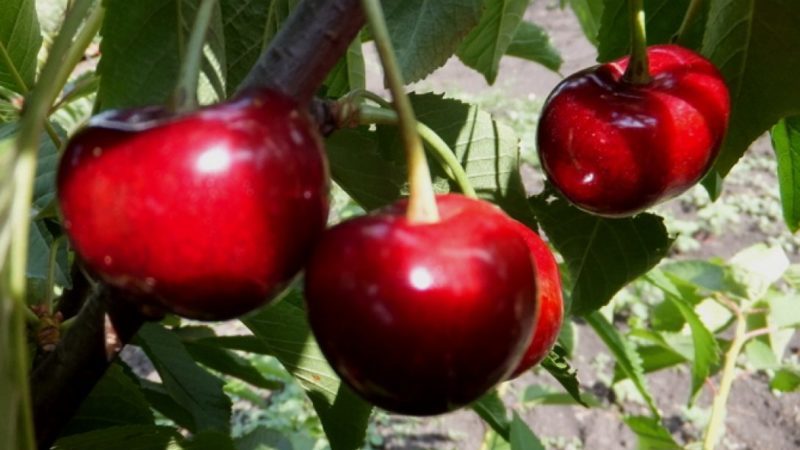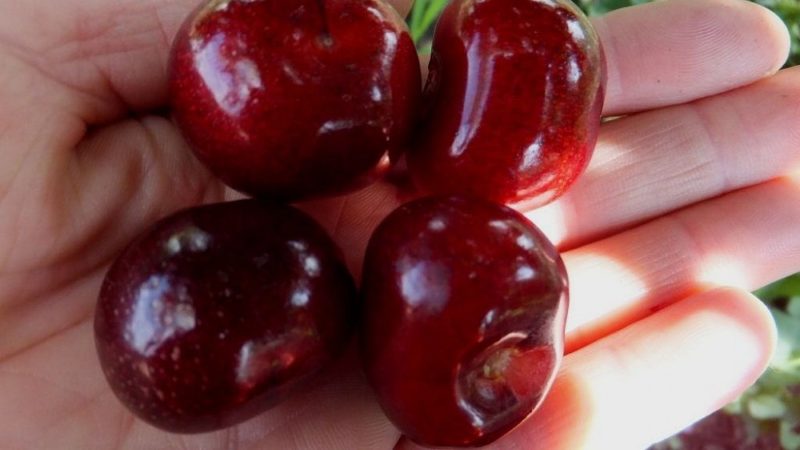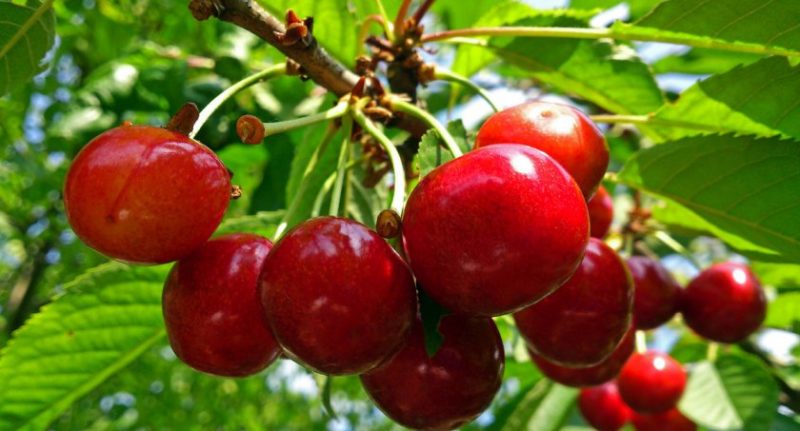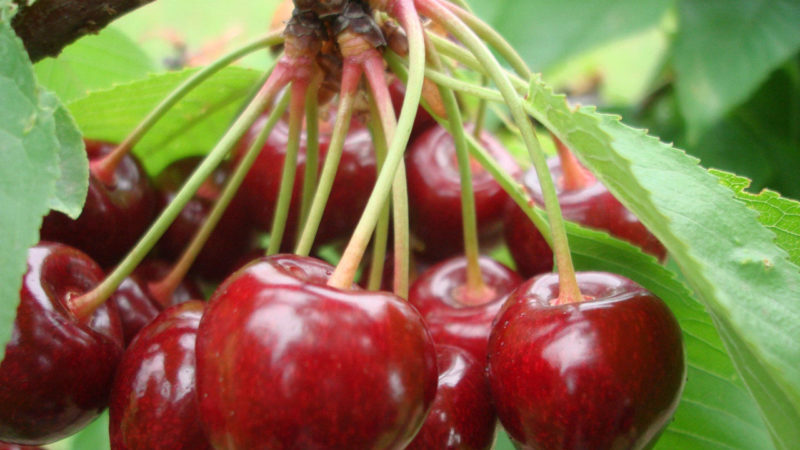Weather-resistant sweet cherry variety Vasilisa with large and tasty berries
Vasilisa is a large-fruited medium-ripening cherry variety. Its advantages are a pleasant dessert taste of berries, frost resistance and a consistently high yield. We will tell you in detail about the characteristics of this variety and its requirements for planting and care.
The content of the article
Description of the cherry variety Vasilisa

This is a mid-season cherry variety - the harvest ripens in the first half of June. Fruiting begins 3 years after the trees are planted, they gain full strength at 4-5 years of age. Average yield, depending on growing conditions (soil composition, climate of the region) - 25-50 kg per tree.
Reference. The maximum fruitful age of Vasilisa is 15-20 years.
The readiness of the harvest for harvesting is judged by the color of the skin - when it becomes deep red, the berries are picked together with the stalk to increase their keeping quality. At a temperature of + 1 ... + 3 ° C, the fruits are stored for 3-5 days.
History of origin and distribution
Vasilisa was bred in the early 2000s. Ukrainian breeders led by L.I. Taranenko at an experimental gardening station as a result of cross-crossing of Donetsk beauty and Donetsk coal.
Characteristics and description of trees
Sweet cherry Vasilisa is a tall, up to 4 m, tree with a branched root system, a dense and spreading crown of a spherical shape and thick, strong, slightly curved shoots. The bark of young plants is reddish-brown, becoming grayish as it grows.
Reference. The crown occupies ⅔ of the entire tree height.
Leaves are large, dark green in color, ovoid with pointed tips and serrated edges, located on long petioles.
In late April - early May, white flowers appear on the trees. Each bud produces 3-5 peduncles.
Resistant to temperatures
Trees tolerate an increase in air temperature up to + 40 ° C and a decrease in temperature to -25 ... -30 ° C. Returning spring frosts are detrimental to buds, flowers and ovaries.
Moisture and drought resistance
Thanks to the deep root system, the trees continue to develop and bear fruit even in drought conditions. To obtain a bountiful harvest in the current and next year, trees are regularly watered, preventing the soil from drying out.
Excessive, untimely watering and heavy rains lead to cracking of the berries.
Disease and pest resistance
The variety is characterized by high resistance to diseases and pests, but the possibility of damage to trees by moniliosis, cytosporosis, gum, cherry flies, cherry shoot and fruit moth is not excluded.
Characteristics and description of berries

The berries are large (average weight - 11-14 g), rounded, covered with a smooth, shiny, dense skin, which, after ripening, acquires a deep red color.
The pulp is red, firm, fleshy, gristly. Has a sweet taste with a slight sourness and a slight wine aftertaste. The stone is round, easily separated from the pulp.
Areas of use
The main purpose of Vasilisa berries is fresh consumption.At the same time, they are also suitable for processing: making compotes, jams, syrups, preserves, confiture and other preparations.
Reference. Sweet cherries are often frozen. In this form, the berries do not lose their antioxidant and tonic properties.
Advantages and disadvantages of the variety
The main advantages of Vasilisa:
- high degree of frost and drought resistance;
- large-fruited;
- immunity to diseases and pests;
- rich chemical composition and high commercial quality of berries;
- abundant productivity;
- keeping quality and transportability;
- the possibility of universal use of fruits.
Cons of the variety:
- the need for pollinators;
- tendency to crack berries in case of heavy rainfall or improper watering.
Growing technology

Sweet cherry is a capricious fruit crop. For the survival of seedlings, the development of trees and high yields, it is important to choose the right place and timing of planting and provide the plants with care.
Optimal conditions
Vasilisa grows in a loose, light, fertile soil with neutral acidity and moisture and air permeability.
Reference. Lime or dolomite flour is added to acidic soil in advance at the rate of 300-500 g of substance per 1 m².
When buying seedlings, choose 1- or 2-year-old specimens with an even, smooth trunk from 2 cm in diameter, 3-4 branched shoots, swollen, elastic buds and a developed, not dry root system.
Immediately before planting, the roots are soaked in a mixture of water, clay and a growth stimulant ("Kornevin", "Epin"), the central trunk is cut to 80 cm, the lateral shoots - up to 20 cm.
Terms and rules of landing
Cherries are planted in spring, when the soil warms up to + 5 ° C, or in autumn, about 1.5 months before frost (late September - early October).
For Vasilisa, they choose an illuminated, sunny place, protected from gusty winds, on a slope in the south or south-west direction, where melt and rainwater does not accumulate. The depth of the groundwater is at least 2.5 m.
Landing technology:
- 2 weeks before planting, on a site dug up and cleared of plant debris, every 3.5-4 m, dig planting holes with a diameter of 0.6-0.8 m and a depth of 0.5-0.7 m.
- Place on the bottom of each drainage layer of gravel or broken brick no more than 20 cm thick.
- Lay the nutrient mixture on top (1 part of peat, humus, river sand and fertile soil layer, 40 g of superphosphate and 500 g of wood ash).
- Drive in support stakes on both sides of the center of the pit.
- Form a hill of soil mixture in the pit, install a seedling on it, spreading the roots along the slopes.
- Cover the seedling with soil so that there are no voids around the roots, and the root collar is at the same level with the soil surface or is 5 cm higher.
- Tamp the ground, form an irrigation furrow.
- Water the plants at the rate of 10 liters of water each.
- Mulch the trunk circle.
- Tie the seedling to the support with elastic bands.
Other varieties of cherries, cherries, cherry plums or berry bushes are planted next to Vasilisa. Unwanted neighbors are nightshade crops, conifers, tall fruit and ornamental trees.
Further care
In case of sufficient rainfall, trees are watered 3 times per season:
- during the growing season and flowering (April - May) - 15-20 liters of water;
- at the beginning of fruiting (early June) - 15-20 liters of water;
- before winter (late September - early October) - 30-40 liters of water so that the soil is saturated with moisture to a depth of 70-80 cm.
In case of drought, they are guided by the state of the soil, preventing it from drying out. On average, watering is carried out every 3-4 days at the rate of 10-15 liters per tree.
To avoid cracking the berries, watering is stopped 2 weeks before harvesting.
Reference. Sweet cherries are watered not at the root, but in circular grooves along the perimeter of the crown.
They begin to feed Vasilisa 2 years after planting the seedlings by introducing a urea solution (30 g per 10 l of water) into the irrigation furrow. After 4 years of active fruiting, fertilizers are applied 2 times per season:
- April - 300 g of dry urea;
- September - 300 g of superphosphate and 100 g of potassium sulfate.
It is permissible to add compost or rotted manure. Fresh organic matter will burn the tree roots.
Every year, a tree trunk is whitewashed to a height of 1.2 m with a lime-clay mixture. This protects plants from pests and fungal diseases.
Every spring, the crown is pruned, removing damaged, frozen, growing inward shoots. They begin to form from the first year of tree life: side branches are shortened by 20 cm, skeletal ones are made shorter than the central shoot by 15 cm, and branches growing at an acute angle to the trunk are cut out.
When forming the crown along the tiers, the distance between them should be 60-70 cm.
Possible problems, diseases, pests
Diseases and pests dangerous for Vasilisa are presented in the table.
| Disease / pest | Signs | Treatment / prevention |
| Moniliosis | The eyelids dry, look burnt, the berries rot. | Treatment with copper sulfate, Nitrofen, Horus. For prevention, the trunks are whitened in the fall. |
| Cytosporosis | Dark spots appear on the bark, the branches become brittle. | Infected tree parts are removed with a sharp, sterile instrument. |
| Gum | A viscous liquid of amber color appears on the cracks of the trees. | To exclude the possibility of fungi and viruses entering through the cracks, they are treated with copper sulfate for disinfection and covered with garden varnish. |
| Cherry fly | Holes are visible on the skin of the berries, the pulp becomes loose. | Plants are treated twice (with an interval of 10 days) with insecticides, for example, "Fury", "Confidor", "Fufanon", "Aktellik". |
| Cherry shoot and fruit moth | Small caterpillars can be seen on the trees. | Treatment of trees with an infusion of wood ash, soap shavings and vinegar. |
To protect the berries from birds, the crown is covered with a special net, and stuffed animals are installed in the garden.
Wintering
Trees do not need winter shelter. Preparing for winter consists in abundant water-charging irrigation in the fall, after which the near-trunk circle is loosened and mulched, and the trunk is wrapped in mesh and agrotextile to protect it from rodents.
Reproduction
Vasilisa is propagated by cuttings or grafting. In the first case, a high yield of seedlings, but a fruiting tree from the cuttings grows at least after 5 years.
Grafting is the most effective way to get high-quality seedlings quickly. Ripe cuttings are grafted onto strong adult trees. It also helps to improve the flavor of the berries, increase the yield and resistance of trees to frost and disease.
Features of cultivation depending on the region

Vasilisa grows successfully in the southern regions and temperate latitudes. In the northern regions, the climate of which is characterized by long and frosty winters, the variety is not cultivated due to the high risk of death of seedlings.
Vasilisa's care requirements do not depend on the growing region. Only the planting time of seedlings varies: in the middle lane it is carried out in the spring, before the start of sap flow, in the south - in the fall, at the end of September.
Read also:
Pollinating varieties
Vasilisa is a self-fertile sweet cherry. In order for the trees to bear fruit, at least 2 pollinator varieties are planted nearby.
Suitable pollinators for Vasilisa:
- Bigarro early;
- Burlat;
- Starking;
- Valery Chkalov;
- Melitopol early;
- Annushka;
- Drogana yellow;
- April;
- Valeria;
- Donetsk coal;
- Bagration;
- Early ripening;
- June early.
Gardeners reviews
Gardeners speak positively about the variety.
Victoria, Volgograd: "I have been growing Vasilisa for more than 7 years. I am very pleased with this variety - for all the years the trees have never got sick with anything, the berries are tasty, and the yield is so high that during fruiting the branches have to be propped up so that they do not break under their own weight. "
Gennady, Krasnodar: “I really like the taste and size of the Vasilisa berries.The only drawback is that they are kept fresh for only a few days, so you need to process them as soon as possible. My wife cooks jam, compotes and freezes, so we enjoy cherries not only in summer, but also in winter ”.
It is interesting:
A young, but gaining popularity among gardeners variety of cherries Revna.
Large-fruited, unpretentious sort of columnar cherry "Sylvia".
Conclusion
Vasilisa is one of the most popular varieties of cherries from domestic and foreign gardeners. This is due to its many advantages, including frost and drought resistance, large fruit size, immunity to diseases, excellent taste and high commercial quality of berries.